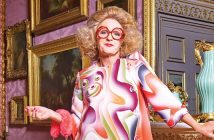Witches covens, assassinations, a cannibalistic Saturn and glowering colossus – the paintings by Francisco de Goya (1746 – 1828) most familiar to us today are nightmarish visions. Looking at these images, a phrase from the equally gloomy and violent Game of Thrones keeps running through my mind, “the night is dark and full of terrors”…
And with such sinister and perverse creations to arrest our attention, the Spanish artist’s portraits of duchesses and kings and cardinals easily pale into the background. There has never been an exhibition [in the UK]focusing on Goya as a portraitist, despite the fact that this genre comprises a third of his total output, some 150 surviving paintings. Over the past 15 years the National Gallery has been working on an exhibition that would readdress this, and the result is a masterful display of 70 portraits spanning an 80-year career, many of which have never been lent abroad before.

The Count of Floridablanca
Francisco de Goya
1783
They feature a cast of protagonists as scheming, endangered and despotic as anything you’ll find in Kings Landing (to continue the GoT analogy). Key players of the Ancien Regime, Napoleonic generals, the Bourbons – Goya painted them all and appeared to have an impressive ability to negotiate these changes of regime, staying in favour of those in power as well as the exiled intellectuals with whom his sympathies really lay.
Goya’s early years were not all that promising; he twice failed to get into the Real Academia de Bellas Artes de San Fernando (instead he went off to Italy to study the Old Masters) and was in his late thirties when he secured his first portrait commission from the The Count of Floridablanca (1783), the scarlet clad figure who greets us in the gallery’s first room. Goya certainly made up for the slow start though; three years later King Charles III gave him a salaried position as a court painter, and in 1799 he was made First Painter to Charles IV.
In Floridablanca’s portrait, already we see Goya inserting himself into the painting, a habit he would continue right through his career. This is one of the many ways in which he was influenced by Velazquez, who had been court painter 150 years before, and nowhere is this more keenly felt than The Family of the Infante Don Luis de Bourbon (1783-4). In a composition paying homage to Las Meninas (as well as perhaps Joseph Wright of Derby in the theatrical lighting) Goya is seated at his easel, a small girl peering at him to draw our attention, while. And there in Duchess of Alba (1797), one of his most famous portraits and poster child of the exhibition, we see the words ‘solo Goya’ written in the sand, an addition that fuelled gossip that the pair were lovers. This portrait was apparently painted after the duchess stormed into Goya’s studio and demanded he apply her make-up.
It’s not all about him. Far from it – Goya had a gift for cutting right to the quick in his portraiture, a searing analytical sight that saw straight through the trappings of wealth, all those velvets and silks, to winkle out the very essence of his grand sitters, and even include veiled jokes at their expense.

The Duchess of Alba
Francisco de Goya
1797
Just look at Ferdinand VII in Court Dress (1814-5). Resplendent in a scarlet cloak, sword and sceptre, from a distance it seems a textbook royal portrait. But look closer and the splayed angle of the king’s feet and twist of his head seem to suggest that beneath all this pomp and pretension lies a crooked, divisive figure. There was no meeting of minds between the artist and the ruler who reinstated the Inquisition, abolished the liberal constitution and banished many of Goya’s friends – described by historian Stanley Payne says, “the basest king in Spanish history”. It is no stretch to imagine Goya slipping in a few slights to Ferdinand’s character.
Contrast this with The Duke of Wellington (1812-4), where Goya’s admiration is evident. Painted after Wellington’s victorious entry into Madrid, the medals and uniform seem (which were later modified when he received further honours) to fall into the shadow of the man’s direct, alert gaze and animated expression. Goya seems to be saying this is a true leader, not one who relies of pomp and splendour.
It is easy to get drawn into the politics and personalities that Goya’s portraiture so wonderfully captures – he was, after all, painting through a period of great upheaval. But equally impressive is his innovative technique, which so often appears to prefigure the masterpieces of much later artists. In the abstract dashes and flicks of the gilded trim on Ferdinand VII’s cloak there is a hint of Pollock, and perhaps a late Rothko in the tonal backdrop of paintings such as Juan Antonio Llorente (1810-2). In the Countess of Altamira and her Daughter, Maria Agustina (1787-8), a gorgeous duo in a cloud of pink satin and white tulle, this impressionistic brushwork is used for the embroidery and ornate gilded chair, and in the unflinching realism and psychological intensity of these paintings we are reminded of how Manet would be wowed by and emulate Goya’s work half a century later.
Innovative, ambitious, adaptable, prolific – Goya has given us a sublime catalogue of the good, the bad and the ugly in early 19th century Spain.
Goya: The Portraits at the National Gallery, London until 10 January 2015. For more information and tickets visit the website.




